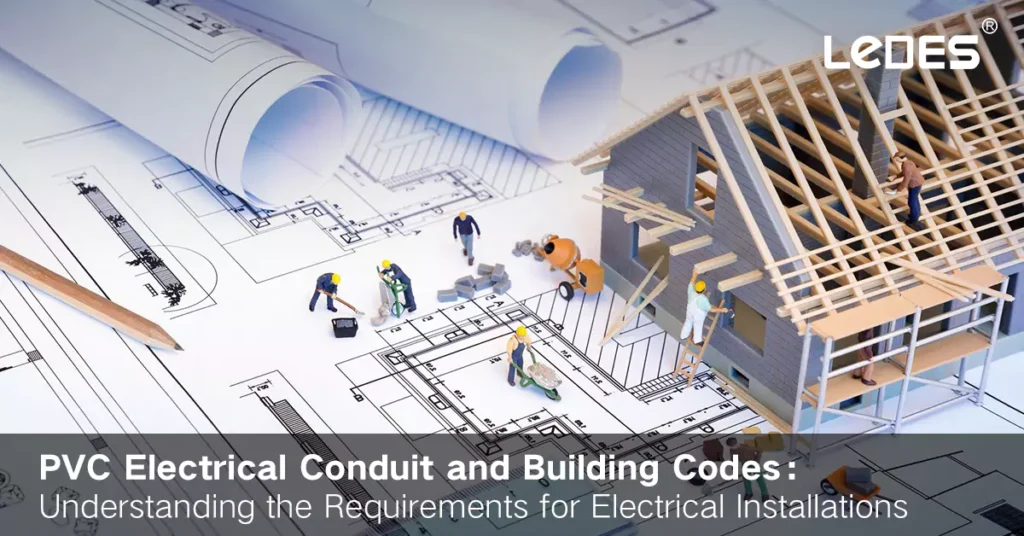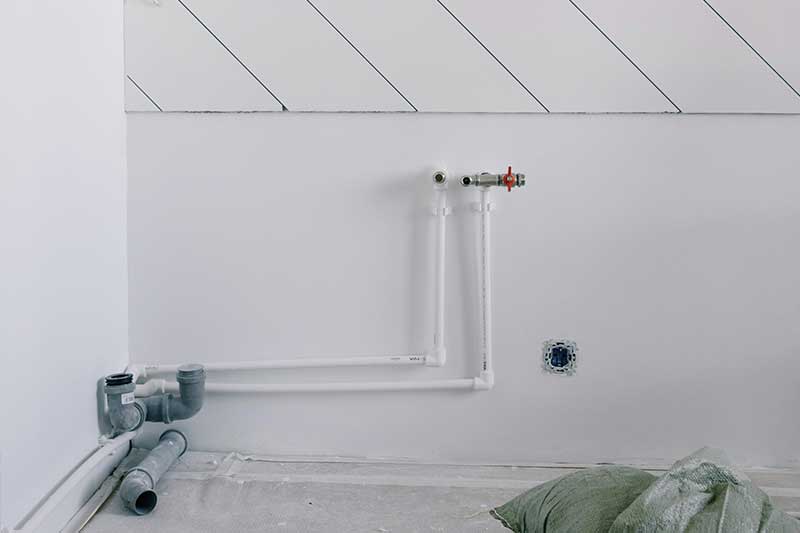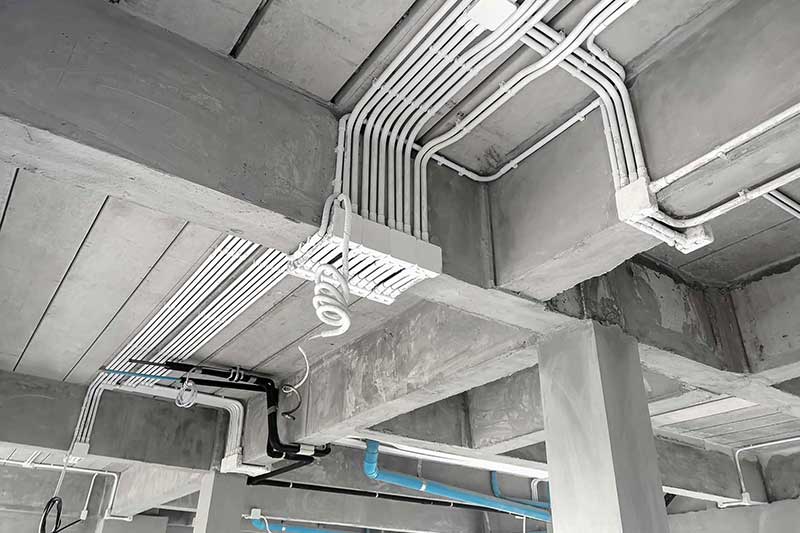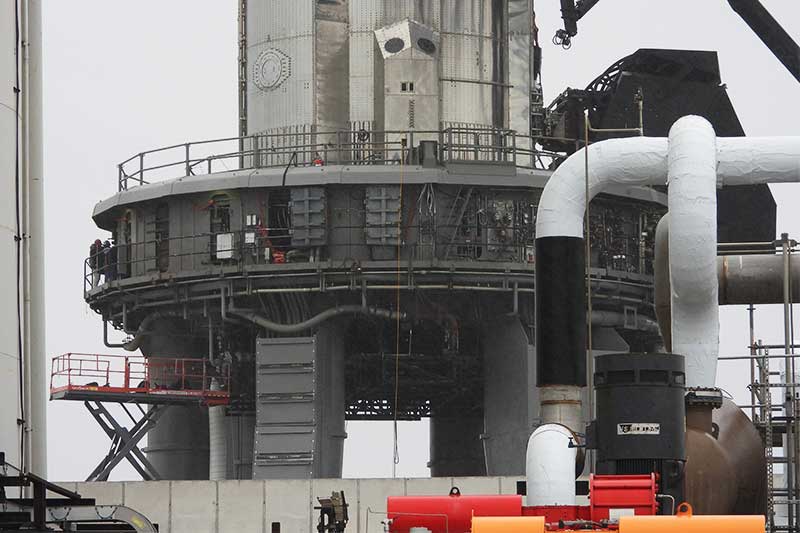
جدول المحتويات
PVC (polyvinyl chloride) electrical conduit is a popular choice for protecting and routing electrical wiring in homes, commercial buildings, and industrial facilities. However, the use of PVC conduit is subject to building code requirements that can vary depending on the type of installation and the location of the building. In this article, we’ll explore the building code requirements for PVC electrical conduit in residential, commercial, and industrial installations, and what you need to know to ensure that your electrical installation is up to code.
Building Code Requirements for PVC Electrical Conduit
Building codes are regulations that set minimum standards for the design, construction, and maintenance of buildings and structures. These codes are developed by national and international organizations, such as the National Fire Protection Association (NFPA) and the International Code Council (ICC), and are often adopted and enforced by state and local governments. The building codes that apply to PVC electrical conduit installations depend on the type of installation and the location of the building.
Residential Installations
In residential installations, PVC electrical conduit is typically used to protect and route electrical wiring for lighting, outlets, and appliances. The National Electrical Code (NEC), which is developed by the NFPA, sets the minimum requirements for electrical installations in residential buildings. According to the NEC, PVC electrical conduit must be used in certain situations, such as outdoor installations, wet locations, and locations subject to physical damage.
More specifically, the NEC requires PVC electrical conduit to be used in the following situations in residential buildings:
– Outdoor Installations: PVC electrical conduit must be used to protect and route outdoor electrical wiring. This includes wiring for outdoor lighting, irrigation systems, and other outdoor electrical devices.
– Wet Locations: PVC electrical conduit must be used to protect and route electrical wiring in wet locations, such as bathrooms, kitchens, and laundry rooms. This includes wiring for outlets, lighting fixtures, and other electrical devices.
– Locations Subject to Physical Damage: PVC electrical conduit must be used to protect and route electrical wiring in locations subject to physical damage, such as areas with foot traffic or areas where equipment may be moved. This includes wiring for outlets, lighting fixtures, and other electrical devices.

Commercial Installations
In commercial installations, PVC electrical conduit is often used to protect and route electrical wiring for lighting, HVAC systems, and other building systems. The International Building Code (IBC), which is developed by the ICC, sets the minimum requirements for electrical installations in commercial buildings. According to the IBC, PVC electrical conduit must be used in certain situations, such as where wiring is exposed to physical damage, in damp or wet locations, and in locations where corrosive conditions exist.
More specifically, the IBC requires PVC electrical conduit to be used in the following situations in commercial buildings:
– Exposed Wiring: PVC electrical conduit must be used to protect and route exposed electrical wiring, such as wiring for lighting fixtures and HVAC systems.
– Damp or Wet Locations: PVC electrical conduit must be used to protect and route electrical wiring in damp or wet locations, such as bathrooms, kitchens, and laundry rooms. This includes wiring for outlets, lighting fixtures, and other electrical devices.
– Corrosive Conditions: PVC electrical conduit must be used to protect and route electrical wiring in locations where corrosive conditions exist, such as areas with chemicals or water exposure. This includes wiring for HVAC systems and other electrical devices.

Industrial Installations
In industrial installations, PVC electrical conduit is commonly used to protect and route electrical wiring for machinery, motors, and other industrial equipment. The National Electrical Manufacturers Association (NEMA) sets the minimum requirements for electrical installations in industrial facilities. According to NEMA, PVC electrical conduit must be used in certain situations, such as in locations where corrosive conditions exist, in damp or wet locations, and in locations subject to physical damage.
More specifically, NEMA requires PVC electrical conduit to be used in the following situations in industrial facilities:
– Corrosive Conditions: PVC electrical conduit must be used to protect and route electrical wiring in locations where corrosive conditions exist, such as areas with chemicals or water exposure. This includes wiring for machinery, motors, and other industrial equipment.
– Damp or Wet Locations: PVC electrical conduit must be used to protect and route electrical wiring in damp or wet locations, such as areas with water exposure. This includes wiring for machinery, motors, and other industrial equipment.
– Locations Subject to Physical Damage: PVC electrical conduit must be used to protect and route electrical wiring in locations subject to physical damage, such as areas with heavy equipment or areas with foot traffic. This includes wiring for machinery, motors, and other industrial equipment.

Ensuring Compliance with Building Code Requirements
To ensure compliance with building code requirements for PVC electrical conduit installations, it’s important to consult with a licensed electrician or building inspector. These professionals can help determine the specific requirements for your installation, and can ensure that all work is done in compliance with local codes and regulations. Additionally, it’s important to use PVC electrical conduit products that are certified by recognized testing organizations, such as Underwriters Laboratories (UL) and the Canadian Standards Association (CSA).
In conclusion, PVC electrical conduit is a popular choice for protecting and routing electrical wiring in residential, commercial, and industrial installations. However, the use of PVC electrical conduit is subject to building code requirements, which can vary depending on the type of installation and the location of the building. To ensure compliance with these requirements, it’s important to consult with a licensed electrician or building inspector, and to use PVC electrical conduit products that are certified by recognized testing organizations. By following these guidelines, you can ensure that your electrical installation is safe, reliable, and up to code.
اتصال
That’s it. If you want to learn more about our products & services, you can contact us by تقديم نموذج الاتصال. Or you can quickly contact our sales engineers via What’s app to get product catalogues and samples.



